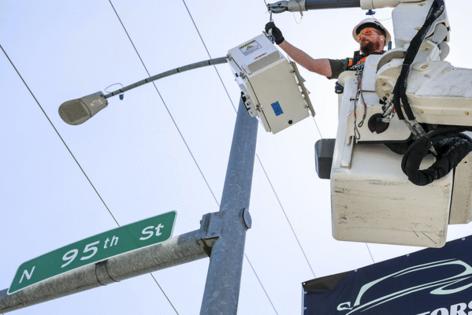Seattle police cameras, now up and running, draw constitutional concerns
Published in News & Features
SEATTLE — As Seattle police use newly installed cameras to watch over areas with high crime rates, civil liberty advocates have expressed concerns over personal privacy and more government intrusion into everyday lives.
The reelection of President Donald Trump has only served to amplify those apprehensions, while adding a new level of unease. The administration's willingness to push constitutional norms leaves critics asking whether now is the time to increase the ability of police to track us.
Given the political climate and the risks that are at stake, you have to question the expansion of surveillance technologies," said Tee Sannon, the technology policy program director at the American Civil Liberties Union of Washington. "Because once you have it, the potential for abuse skyrockets."
The center’s proponents say that instantaneous data and information will result in better policing and fewer instances of innocent people being stopped by police simply because they fit the description of a suspect, resulting in hard feelings and community mistrust.
“We need to know how to leverage technology to help keep people safe,” said Chief Shon Barnes, who will be overseeing the project. “It’s one tool. It has its shortcomings. It’s not a panacea, but we live in a technology-driven world. Truth is, we are all on camera all the time.”
The ACLU urged residents in a flyer this year to “reject mass surveillance” in Seattle, arguing that the city’s plan expands surveillance technologies that have not been proved to reduce crime and could contribute to “the historic disproportionate over-policing and over-surveillance” of communities of color.
In the face of these and other criticisms, the city this spring began installing dozens of cameras in the Chinatown International District and along Aurora Avenue in North Seattle, both high-crime areas. More are on the way.
City officials ensure the surveillance systems will be subjected to rigorous oversight and their operations closely monitored to protect the public's civil rights.
"The safeguards are all there," said Deputy Mayor Tim Burgess, a former interim mayor, City Council member and Seattle police officer who advises Mayor Bruce Harrell on police matters. Cameras have been installed in public places, and the city has erected signs alerting passersby of the surveillance, he said.
"There's no expectation of privacy walking down a public sidewalk or crossing the street. These systems will be focused on preventing serious, felony crimes," not keeping tabs on the citizenry, he said.
As for the concerns about the federal government co-opting the center for its own purposes, Burgess says city ordinance already prevents Seattle from cooperating with federal immigration enforcement.
Regarding any other potential incursion, Burgess and others defending the expansion of police surveillance all have invoked an almost talismanic phrase they believe stands as the biggest barrier to the Trump administration: "This is Seattle" — a very blue city in a blue state.
Burgess and other city officials point to extensive safeguards built into the system via the 2017 Seattle Surveillance Ordinance, and amendments made the next year, which require city departments to get City Council approval for the use of any surveillance-related technologies. The ordinance also calls for the city's Office of Inspector General to report on the impacts that proposed technologies might have on privacy and civil rights, and to review technologies now in use to ensure they comply with city ordinances and the law.
Even so, officials acknowledge the fraught political climate and the demonstrated willingness of the Trump administration to use aggressive measures — like deporting people to El Salvador and South Sudan who are not from there. Talk of Trump's imposing martial law and the deployment of the National Guard and Marines to quell protests in Los Angeles haven’t helped.
Seattle public safety Inspector General Lisa Judge, whose office will monitor the use of the technology and issue regular reports, referenced the president's pushback against lawful court orders and the Department of Justice's apparent pursuit of a Trump enemies list.
"We are concerned," Judge said. "What we have seen from this administration is terrifying."
"But we are all on the same page," she added, referring to the mayor's office, City Council and the Police Department. "We are very aware that we do not want to keep or share some record that might land someone on a plane to El Salvador."
How real time crime centers work
Real time crime centers like Seattle's are popping up all over, and their use and influence are expanding rapidly. They are all but ubiquitous in big cities — London, the target of Irish Republican Army bombings in the 1980s and early '90s, is famous for its "Ring of Steel" and its extensive surveillance system that can follow a person, on foot or in a vehicle, from one end of the city to the other.
Likewise, New York City spent more than $11 million developing a real time crime center that incorporates a sprawling system of closed-circuit television cameras, license plate readers, gunshot detection systems and facial-recognition software to support its 36,000 police officers and 78 precincts. The center is staffed 24/7 and has an annual operating budget of $5 million.
The Seattle Real Time Crime Center is staffed by analysts using real time data from dispatch, 911 calls and other sources along with surveillance software to isolate criminal activity and get accurate and useful information to officers as events unfold.
The center is now operating 19 hours a day, using eight analysts to monitor 48 cameras, with the city planning to hire four more analysts this year, the department said. Eventually, 65 cameras will be in place.
Once the center is fully funded next year, the city plans to hire nine additional analysts and operate the center around the clock.
"The RTCC started training with the system and cameras in May," said Barbara DeLollis, the Police Department's new chief communications officer. "Since then, the RTCC has assisted patrol officers in over 600 real-time events and assisted investigations in over 90 active (cases)."
Even partly staffed, the center is actively using surveillance technologies to assist officers, the department said. City leaders are holding an event at the Real Time Crime Center on Tuesday to celebrate what they called "early successes."
The city pointed to two examples.
In May, an analyst used surveillance camera video to locate the driver of a recovered stolen vehicle. The analyst spotted the suspect walking on 12th Avenue South near King Street in the Chinatown International District and police arrested the person. A clip of the video then was placed into evidence.
Two weeks later, an analyst partially identified a suspect vehicle in a hit-and-run in the same area, leading to another arrest.
The city says the Seattle Real Time Crime Center won't deploy any of the more controversial technologies used elsewhere, such as facial recognition software or gunshot-location technology, the first considered too intrusive and subject to possible abuse, the second because of reliability issues.
The Seattle Police Department has experimented with facial recognition technology before; however, spokesperson Sgt. Patrick Michaud said a pilot program introduced in 2014 is no longer in use.
And Harrell pushed hard for more than two years for the City Council to fund a gunshot-location system called Shot Spotter, but the city shelved the effort in 2024 after reviewing its questionable effectiveness in other cities.
Real time crime centers have become increasingly popular as cities move toward data-driven policing and seek solutions to police staffing issues. The interest has spawned a trade group and professional organization, the National Real Time Crime Center Association in Scottsdale, Ariz., whose sponsors include some of the biggest providers of both surveillance hardware and software in the country.
Its president, Matt Patin, says there are more than 300 real time crime centers planned or operating in U.S. cities.
Transforming Seattle's Real Time Crime Center
Seattle's Real Time Crime Center is not new. It was first opened in 2015, established by Mayor Ed Murray and police Chief Kathleen O'Toole, who set aside a room on the seventh floor of the Seattle Police Department's headquarters. But its walls of massive TV screens showing real-time dispatches and other data were primarily used by analysts to inform precinct commanders of crime trends. Very little data was used in "real time" to fight crime, according to police officials.
Harrell proposed upgrading and expanding the Real Time Crime Center not only to take advantage of emerging technologies, but to bolster a Police Department that has seen an exodus of officers and challenges recruiting new ones. Harrell sees the center as a "force multiplier" that will help officers become more efficient at fighting crime.
The City Council has given Harrell $1.8 million to deploy the first 65 surveillance cameras overlooking "strategic" Seattle crime hot spots: the area around 12th Avenue and Jackson Street in the Chinatown-International District, in Pioneer Square and along the downtown Third Avenue bus corridor, and on North Aurora Avenue. Another $2 million will help bring the center to 24/7 staffing next year, according to the mayor's office.
Overseeing the center will be Barnes, Harrell's pick for police chief, who has an extensive background in evidence-based policing.
While he was deputy chief in Salisbury, N.C., Barnes oversaw the formation of the third real time crime center in the state.
He acknowledges that "people are worried about police watching people," but says those fears can be assuaged by transparency and communication. Areas where the cameras will be located and watching will be publicly posted and the data and policy directing the Real Time Crime Center will be available online.
Barnes said he is keen to prevent federal overreach by the Trump administration. "You will find very little similarities between me and my beliefs and the current administration," Barnes said.
Questions over effectiveness
The safeguards now in place won't be enough, predicts Beryl Lipton, a senior investigative researcher at the Electronic Frontier Foundation in San Francisco, a nonprofit aimed at exploring issues of digital free speech, privacy and innovation online. Lipton is curator of the Atlas of Surveillance, which details surveillance technology developed and used by police departments throughout the country.
Lipton says police are rushing to integrate sometimes intrusive or questionably useful technologies without data to prove they actually reduce or prevent crime. She points to studies in Little Rock, Ark., and Detroit that have raised questions about the crime-fighting capabilities of the technology.
Little Rock opened its real time crime center last year, but a representative of the city's provider, Axon, which makes body cameras and RTCC software, could not provide empirical studies that show the technology has reduced crime.
In Detroit, a National Institute of Justice study concluded that Project Green Light, a part of the Detroit Police Department's real time crime center — which includes cameras at more than 500 locations — helped decrease property crime but was "ineffective" at addressing violent crime.
"There are no strong studies that actually show these centers reduce crime," Lipton said in an interview. "Yet more police are acquiring these technologies, collecting data they sometimes don't know what do with. … There is often a lack of structure in these programs."
"Cities end up collecting massive amounts of data, without proper audit or oversight, you end up with law enforcement and individuals using it for their own purposes, and that can be bad," she said.
Data, she said, is meant to be shared and used and there is little to stop law enforcement, or even software vendors, from sharing it intentionally or inadvertently.
And then there's the threat to digital privacy from the Trump administration, which has shown little restraint in using federal databases against undocumented immigrants and has overtly attacked political enemies online and in person.
Lipton notes the FBI already operates "Fusion Centers," joint local and federal intelligence gathering centers. Using those centers to potentially co-opt data from local real time crime centers is not a stretch, she said.
"People are right to be skeptical," Lipton said. "I don't think there is a lot to keep them from accessing this data if they want it.
©2025 The Seattle Times. Visit seattletimes.com. Distributed by Tribune Content Agency, LLC.







Comments